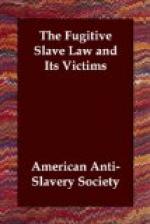to reduce George to slavery at San Francisco.”
He was brought before the United States District
Court, Judge Hoffman presiding, claimed under the
United States Fugitive Law as the property of
the above-named Cooper. [The result of the trial
not known.]—San Jose Telegraph.
At Dayville, Connecticut, June 13, 1855, an attempt was made to seize a fugitive slave; “but the citizens interfered and the fugitive escaped.” He was claimed by a resident of Pomfret, who said he had bought him in Cuba.—Hartford Religious Herald.
At Burlington, Iowa, a colored man, called DICK, was arrested and taken before United States Commissioner Frazee. “Much excitement was caused.” He was claimed as belonging to Thomas Ruthford, Clark County, Missouri. Dick was discharged as not being the man claimed. (June, 1855.)
A white girl, fourteen years of age, daughter of Mr. Samuel Godshall, of Downingtown, Chester County, Pennsylvania, while walking upon the road, was seized by two men, a plaster put upon her mouth, and she taken in a close carriage in the direction of Maryland. After going twelve miles, they put her out of the carriage, “in a secluded and woody portion of the country, threatening to kill her if she made any alarm, when they drove away as fast as they could.” Some colored people met her, got the plaster off her mouth, and aided her home. It was supposed the kidnappers mistook her for a mulatto girl; but discovering their blunder dismissed her.—Philadelphia Ledger, July 9, 1855.
The Norristown (Penn.) Herald relates a case similar to the preceding. Benjamin Johnson, a white lad of fifteen, on his way from his father’s, at Evansburg, to S. Jarrett’s, near Jeffersonville, was invited to ride by a man in a carriage. The man took him by an unusual route; night coming on, the boy was alarmed and attempted to escape, “when the villain caught him and drove off at full speed, and by threats and blows prevented him from making any alarm.” He drove to a distance of fifteen miles beyond Jeffersonville, when the boy succeeded in making his escape. (July, 1855.)
JANE JOHNSON, and her two sons, (colored,) brought into Philadelphia (on their way to New York and thence to Nicaragua) by John H. Wheeler. Stopped to dine at Bloodgood’s Hotel. Jane there made known her desire to be free. Information of the same was conveyed to Passmore Williamson, Secretary of the Pennsylvania Abolition Society, an old association founded by Benjamin Franklin, Benjamin Rush, and others. Mr. Williamson went to the hotel, and found that the party had gone to the steamboat, at the foot of Walnut Street. He proceeded thither, found them, and told the mother that she and her sons had been legally made free by being brought by their master into a free State. After some delay, Jane rose to leave the boat. Wheeler endeavored to detain her.




